Here is the third part of my big blog post series about Japanese textbooks. This time I’m going to talk about books that have something to do with learning kanji, in my opinion one of the biggest challenges when learning Japanese. So here it is today’s blog post (part 3), Japanese study books: kanji
Japanese study books: Kanji
Do I need to learn kanji?
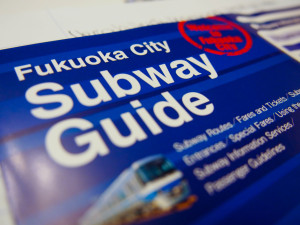
After you mastered hiragana and katakana it’s soon time to begin learning kanji. Some people will tell you that learning kanji isn’t essential. This may be perhaps for understanding the grammar, but once you’ve visited Japan you’ll know that it’s still better to give kanji a little attention because you’ll constantly be confronted with kanji in Japan.
How many are there?
—“2136 kanji”
is the amount
you need to master—
Officialy, Japanese youth need to master 2136 kanji before they graduate. This immense task is something that Japanese people generally achieve through their school careers. But you are trying to achieve this in an often much shorter period. You’ll probably never be able to remember all these kanji (if you can do this, I’m jealous), but with much practice and a method that fits your way of learning, you’ll be able to remember a great deal. This also makes navigating through Japanese culture easier.
Different books, different methods
There are many different methods. Some use the frequent writing of a kanji, another method makes you remember kanji through stories. Which method fits you best is not for me to say, but try them out at least once and you’ll find out for yourself. I use a combination of methods; sometimes I see the meaning of the kanji but sometimes I invent stories around one kanji based on the radicals. Or if that really doesn’t help I try to remember the kanji by writing it a hundred times.
Kanji in grammar study books
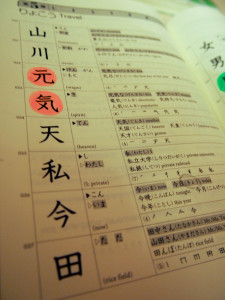
The book series from the previous post, Genki and A Course in Modern Japanese, also have kanji at the end of each chapter. This is often a list of kanji with a number of sample words and the stroke order, but there is no method that explains you how to remember these kanji. So when you start learning you don’t need to immediately buy a separate book for learning kanji. For beginners, the 300 kanji included in these series are a good start.
Kanji study material and there method
Sometimes your memory doesn’t work like you want it to and so you look for other tools or methods. Or you want to learn even more kanji and therefore often need an extra book. Here is the list of my collection of books related to kanji.
Kanji flashcards
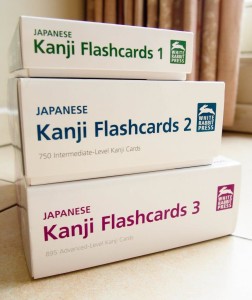
Just like for hiragana and katakana, White Rabbit Press has also released flash cards for kanji. This collection is a beautiful publication. The flash cards come in three volumes, so you won’t need to buy all 2136 cards at once. The first volume contains 300 kanji. These are approximately the same kanji as in the book series of Genki and A Course in Modern Japanese.
What can you find on the cards?
On the front of each card you can find the stroke order and six words containing the kanji, so you can learn kanji in their context. You also find the radical and stroke count (necessary for looking up kanji in a dictionary). On the back are the kun’yomi and on’yomi readings and the translation of the words that are on the front. Lastly, you’ll also see the different elements of the kanji and their meaning.
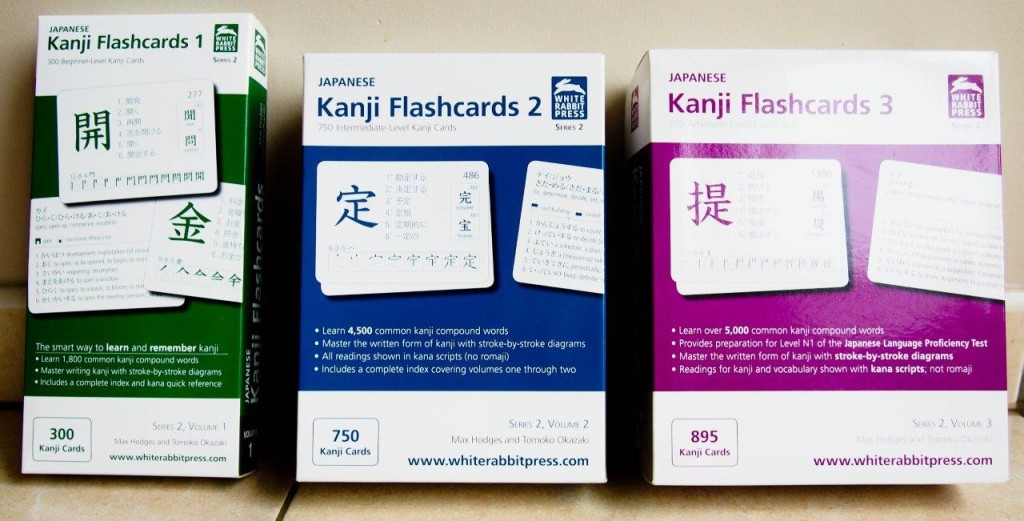
For beginners and for the advanced student

This kanji cards collection is quite an extensive collection. On the cards you can find everything you need to know to master the kanji. Especially if you’re learning the more complex kanji. Volumes two and three contain many more cards, in the same structured layout. The kanji assigned to the volumes are selected so that they correspond approximately to the JLPT levels. For example, if you’re going to take level one or two, you’ll need to learn all kanji in volume three.
Remembering the kanji 1 and 2 (James w. Heisig)
Remembering the kanji 1
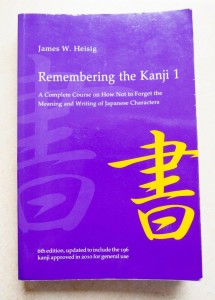
These books with their method are known to most students Japanese. The method consists of learning to recognize the different elements in kanji. Which means will analyze the kanji’s different elements and learn the meaning of the kanji by connecting the different elements. This is backed up with a story that will help you to remember the various elements to understand the kanji and its meaning.
0

My thoughts
This is a book that I regularly use. I have finished reading the book, but of course I don’t remember everything. The method is a bit difficult to combine with the use of grammar books, because the sequence used for learning kanji in most of the books is not the same as in the Remembering the Kanji book.
How I use this book
I use the book when there is a kanji that I can’t remember or a new kanji that I need to learn and with which I have difficulties finding a way to keep it in my head. I then look for it in Remembering the Kanji and I analyze it in hopes of remembering it this time. This method works for me 80% of the time, but sometimes I can hardly see the connection, probably because the book is written in English.
Remembering the kanji 2
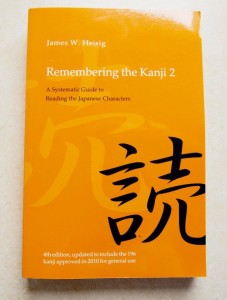
There is also a second book in this collection (and even a third). The second book focuses on the reading of the kanji. For this too, Heisig searched for elements in order to obtain a structure where he can put all the kanji in. You will first learn the reading of the kanji that are formed the basis for hiragana and katakana. The other kanji are classified in other ways. This book is interesting reading material, but I often find it much simpler to learn reading by learning new vocabulary.
Storyで 覚 え る(Learning 300 kanji through stories)
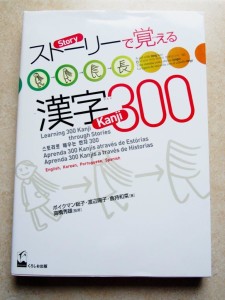
This is a fun book. Just like the Heisig method, it works through stories. But what’s different is that this book also works with an additional visual input. Each kanji is also explained with pictures. You can sometimes learn the meaning of the kanji because you see the meaning of in it.
My opinion
I like this method and for some kanji it is really fascinating to see how original people are. Unfortunately you can’t apply this method to all 2136 kanji. Therefore, there is a limit of two books in this series. At the end you’ll have learned a total of 500 kanji. A nice method but most of the kanji in this book are the basic kanji that everyone learns in the beginning. So if you ‘re looking for tips for learning more difficult kanji you should start looking elsewhere.
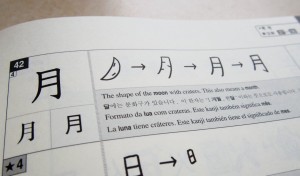
Nihongo so-Matome: Kanji
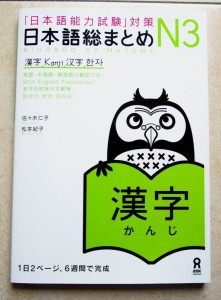
Just as there is a grammar book in this series, there is also a book about kanji. It’s only focused on the kanji that you definitely need to know if you’re going to take JLPT level three. The nice thing about this book is that the kanji are grouped in different situations, which shows you the kanji in real life. You also learn vocabulary that you can encounter every day.
0
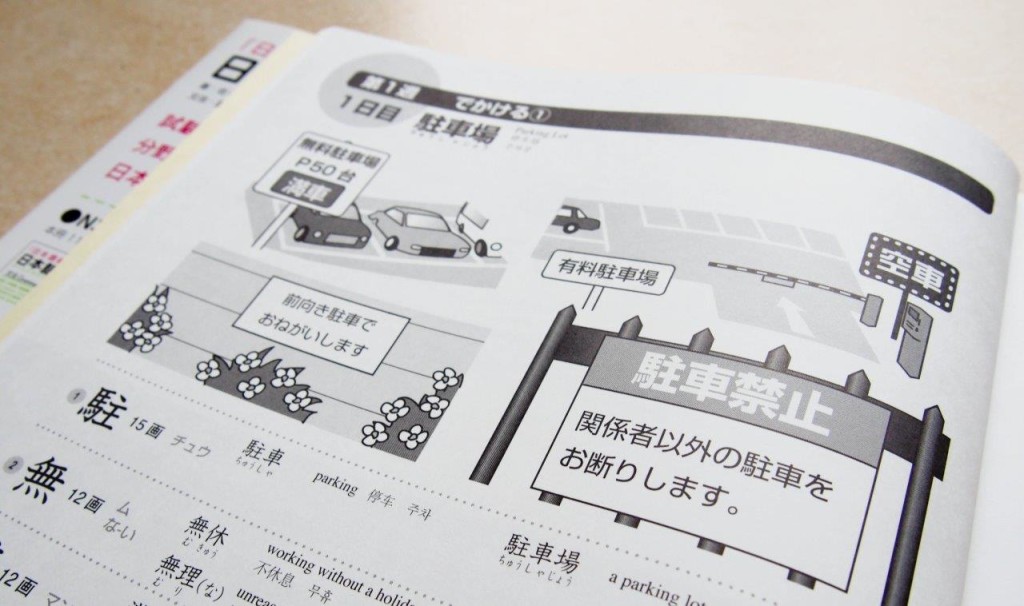
Daigaku Daigakuin-Sei No Nihongo: Kanji and vocabulary
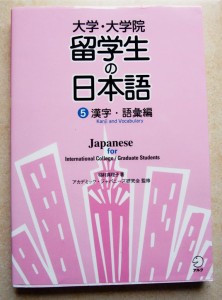
This is the book that students use after the first year of Japanese Studies at the Catholic University of Leuven for learning kanji. It’s a pretty tough/difficult book, because it also focuses on advanced kanji. So it isn’t really suitable for beginners.
There’s only English in the translation of the many words and kanji within the book. The translation of the example phrases is something for yourself to look up. When you finish this book, you know almost all kanji you need to know. Apart from the ten kanji per unit, you need to look up the unknown kanji in the sample words and phrases. If you want a challenge, this book is perfect for you.
Many choices, many methods!
There are many more books to study Japanese. So searching for more information can help you even more. Most of the books do not concentrate specificity one beginners. These kanji are mostly covered by grammar books. So most series have more than only the beginner kanji.
Other post on Japanese study books:
- (Part 1): Kana
- (Part 2): Grammar
- (Part 3): Kanji *You are reading it*
- (part 4): Reading
- (part 5): Listening and speaking
- (Part 6): Dictionaries
- (Part 7): Where to buy?
If you have remarks, suggestions, or questions you can always post them in the comments section, on my Facebook page, Google+ page or through Twitter.
*Subscribe now on the weekly newsletter.
⇒
You can choose between ENG or the NL version*
[wysija_form id=”1″]